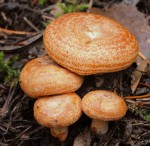G roups or troops of saffron milk cap can be found in summer and fall growing in the calcareous and siliceous soil in coniferous forests especially under pines. It is native to the Mediterranean basin where it is especially prized for eating in Spain and Cyprus. The mushroom is low growing and stands 1.5 to 4 inches tall with a cap to 2.5 inches across. The cap is convex at first but flattens to form a funnel-shape. It is bright orange with concentric rings of darker patches, greasy or dry, and has an inrolled margin. The orange gills are crowded, forked, and run down the stem. The short stem is ½ to 1 1/8 inches in diameter, and has small orange depressions at the bottom and a whitish down on the top. It becomes hallow and soft quickly. The pale orange flesh contains an orange exude that can turn the urine red when the mushroom is eaten in quantity but is harmless. The flesh is easily bruised and turns green forming green patches on both gills and stem.
roups or troops of saffron milk cap can be found in summer and fall growing in the calcareous and siliceous soil in coniferous forests especially under pines. It is native to the Mediterranean basin where it is especially prized for eating in Spain and Cyprus. The mushroom is low growing and stands 1.5 to 4 inches tall with a cap to 2.5 inches across. The cap is convex at first but flattens to form a funnel-shape. It is bright orange with concentric rings of darker patches, greasy or dry, and has an inrolled margin. The orange gills are crowded, forked, and run down the stem. The short stem is ½ to 1 1/8 inches in diameter, and has small orange depressions at the bottom and a whitish down on the top. It becomes hallow and soft quickly. The pale orange flesh contains an orange exude that can turn the urine red when the mushroom is eaten in quantity but is harmless. The flesh is easily bruised and turns green forming green patches on both gills and stem.
Although given the specific name deliciousus, this is not considered a choice mushroom by most people. It is very edible, however, and eaten by many people because of its firm, thick flesh, crisp texture, and herby, spicy flavor. It is best eaten when young and can be broiled, fried in olive oil or butter, salted, pickled, marinated, or dried. When gathering mushrooms from the wild expert advice should be sought on identification before eating.
Photo Credit: By 2009-09-28_Lactarius_deliciosus.jpg: furtwangl from West Seattlederivative work: Ak ccm (talk) – 2009-09-28_Lactarius_deliciosus.jpg, CC BY 2.0, https://commons.wikimedia.org/w/index.php?curid=15286328